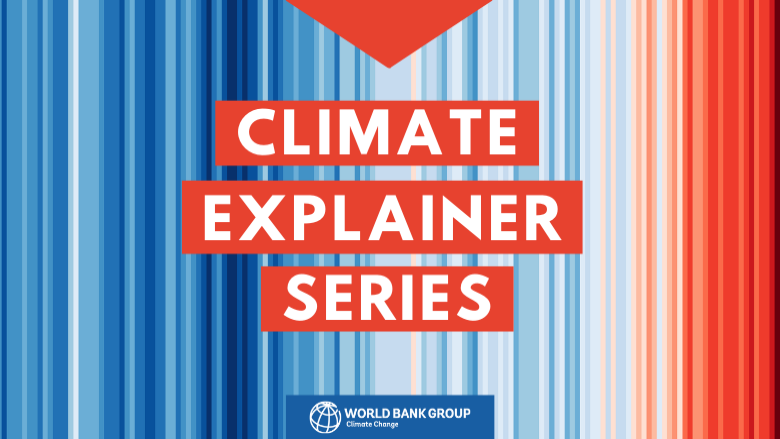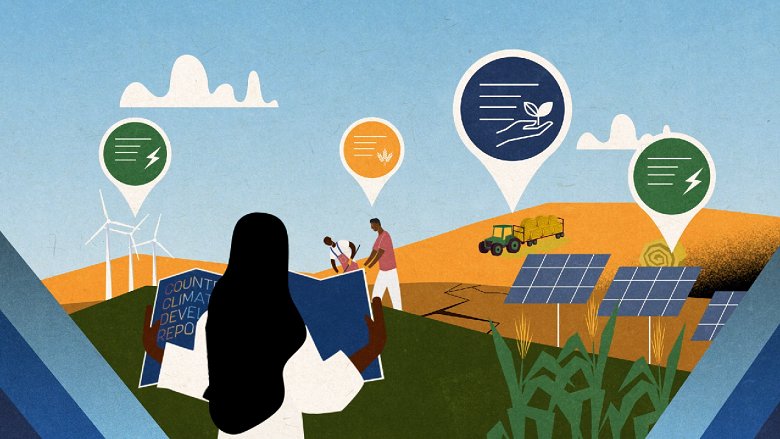Why did the World Bank Group introduce a new diagnostic report to connect development and climate change? Aren’t they different issues for countries to address separately?
Climate change is profoundly connected to development and human wellbeing. Unchecked, climate impacts could push 132 million people into poverty over the next 10 years. Climate change also interacts with other social, economic, and environmental pressures – as is now evident from repeated and more frequent extreme natural events and disasters - compounding risks that can increase vulnerability, exacerbate grievances, and deepen pre-existing fragility. And despite having contributed the least to global greenhouse (GHG) emissions, developing countries are especially vulnerable to the adverse impacts of climate change.
But not only does climate change pose a serious threat to sustainable development, now and in the future, the converse also applies: countries can achieve good development outcomes, including by reducing poverty and boosting sustainable growth, while taking action on climate. Achieving this, though, requires a clear understanding of which interventions will have the highest impact, what they will cost, what are the tough policy choices that may be needed; and that’s what these CCDRs will aim to provide. Development is also critical to take action on climate—countries will have to finance investments and for that economic growth is essential.
We see climate action as fundamental to alleviating poverty and boosting shared prosperity in a sustainable way – a mission that is at the core of the World Bank Group’s development mandate. That thinking is reflected in our Climate Change Action Plan, 2021-25 which makes a concerted effort to support countries and private sector clients to address climate and development challenges together. It starts from the premise that climate and development need to be integrated, both to facilitate successful mitigation and adaptation, and to ensure economic development is sustainable. We think it represents a real paradigm shift for the Bank Group to advance development in a green, resilient and inclusive way—getting climate into our development DNA, as it were.
We see climate action as fundamental to alleviating poverty and boosting shared prosperity in a sustainable way – a mission that is at the core of the World Bank Group’s development mandate.
The new Country Climate and Development Reports (CCDRs) aim to deliver on this integrated approach, connecting climate and development. How are they going to do that?
Our new diagnostic report, the Country Climate and Development Report (CCDR), aims to help countries better understand the climate risk they face as well as plan how to address it while also achieving their development goals.
CCDRs start from each countries’ own development priorities and climate commitments to identify the most effective actions countries can take to make progress on climate and development goals. They provide a strong and rigorous analytical base at the country level from which to consider pathways for the low-carbon, resilient transition. CCDRs are deliberate about centering people and communities in their approach because people will determine the success and sustainability of any climate-focused policy or transition: for instance, they assess how climate risks affect people and communities and how to build their resilience. They are intentionally selective and do not cover all aspects of climate action, focusing instead on what the Bank Group considers to be the highest impact areas of intervention in a given country.
Our new diagnostic report, the Country Climate and Development Report (CCDR), aims to help countries better understand the climate risk they face as well as plan how to address it while also achieving their development goals.
With this solid analytical base in place, CCDRs are then well placed to contribute to public knowledge on climate issues and we intend for them to help inform, prioritize, and sequence climate action. As they are developed, we also seek engagements with multiple audiences including government, civil society organizations, nongovernmental organizations, academia, the private sector, and development partners. They can also be used to support countries prepare and implement their own climate targets – Nationally Determined Contributions (NDCs) and Long-Term Strategies (LTSs).
And for the Bank Group, they feed into our country engagement tools with clients - Systematic Country Diagnostics and Country Partnership Frameworks, other diagnostics, and ultimately our lending, thereby increasing the climate impact of our interventions.
What is the process for developing a CCDR? What kinds of data and analysis go into them?
CCDRs are a Bank Group core analytical product that is prepared while engaging closely with national authorities, the private sector, academia amongst others. CCDRs are expected to be updated every five years, to help fill in knowledge gaps as our understanding evolves and to keep them current.
To provide policymakers with reliable recommendations on a variety of climate-related policies, the Bank Group deploys a diverse and complementary set of models, selected based on the country context, including local climate risks and economic strengths and opportunities. The analytics range from evaluating the aggregate, sectoral, and welfare effects of mitigation measures to assessing country-specific adaptation needs, and considering climate impacts, including the impacts of extreme weather events.
Key indicators include macroeconomic and distributional outcomes (GDP, consumption, poverty, inflation, exchange rates, fiscal impacts, debt), sectoral indicators (energy prices, industrial, agricultural and service sector output), and co-benefits (health and productivity improvements from reduced air pollution, and tax efficiency gains when carbon tax revenues allow a distorting tax to be removed).
These insights are being shared with key counterparts, including policymakers in government, private sector partners, youth and other civil society partners.
It is also important to see this as an iterative process: the process for developing CCDRs isn’t a one-way street, but rather helps to mainstream climate expertise further across the Group. By integrating analysis on climate and climate policies with development and economic indicators, we are also effectively building our own capacity as an institution – teams across all our regions are rapidly advancing their own skills – and further increasing the climate impact of our operations.


